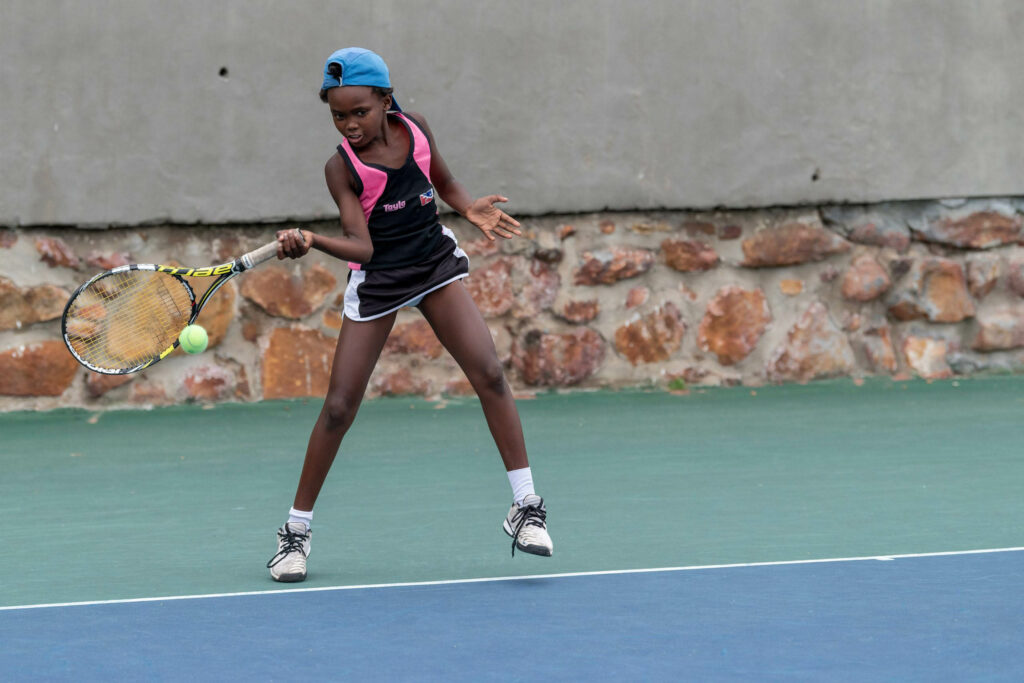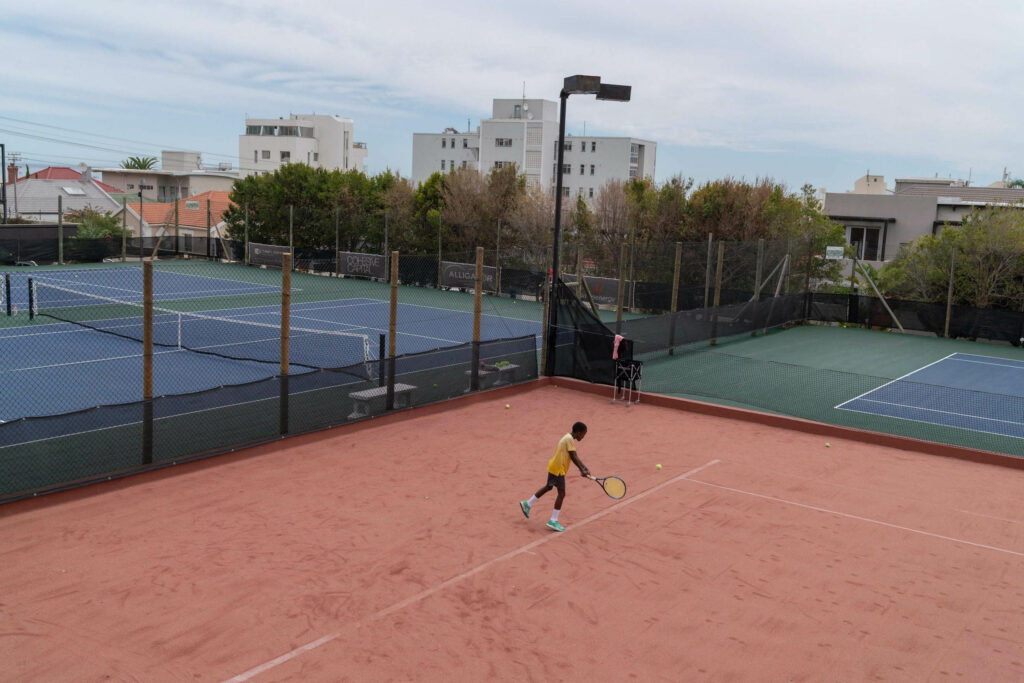Anthony Harris started the academy in 2012 with his wife, Dionne Harris, with the ultimate aim of producing a tennis champion from Africa. (Ihsaan Haffejee)
Rinnah Okanja hits with Serena Williams-like power, her young body exuding strength as she arcs up off the baseline. And she’s only 12 years old.
But this is the type of kid former player and tour coach Anthony Harris had in mind when he founded the Anthony Harris Tennis Academy with his wife, Dionne. It’s a high-performance centre in Sea Point, Cape Town, with the ultimate aim of producing a tennis champion from the continent.
“The goal was to create an African champion … We wanted to make a place that would make sure that if there was any kid out there, doesn’t matter what his background, if he deserved an opportunity and he had what it took, it wouldn’t be because of money that he wouldn’t get this opportunity.”
Lloyd Harris, who shares a surname with Anthony but is not related, is the first from the academy to break into the pro ranks. He had done well as a junior and was looking “to be more serious about my tennis … I went to some tournaments with him [Anthony] and his players. I started seeing how he works. We were doing all these warm-ups and fitness, eating correctly … and it was just way more professional, a way more exciting approach for me,” says Lloyd.
That was seven years ago, and Lloyd reached a career-high ranking of 72 in January, with his sights set on breaking into the top 50 this year.
Rankings are important. It’s what academy players must achieve if they are to realise their goal of turning pro, which to a player is the reason they are there.
“I want to become world No. 1, just like [Rafael] Nadal,” says Israel-Hayward Dowie. The pint-sized nine-year-old is already used to practising with the likes of Lloyd, matching him shot for shot. He recently won his first tournament, taking the boys’ Under-12 title despite his young age.
This is just one instance of the belief and hope that Anthony has set about creating in his players, a key tenet of the academy. “I understood that if we wanted to build and do something for all in tennis, one of the biggest factors that was lacking was belief and hope … An example is a kid we found in Mitchells Plain. The kid is seven years old. He’s playing tennis in the local Mitchells Plain club…”
The kid he’s talking about is 14-year-old Leo Matthysen. “At nine years old, he’s top in the country. We bring him here and the next thing, he qualifies for the World Championships in Croatia,” says Anthony. “We send him and his father to Croatia and suddenly every kid in Mitchells Plain wants to be Leo. So the belief factor and hope are created. Without that, it’s very tough to build a strong foundation of tennis.”
Another chance find was Siyolise Schultz. Dionne’s daughter saw “a little girl hitting on a wall [in a shack settlement] in a Facebook post” and set out to find Siyo.
 Nine-year-old Siyolise Schultz (below) is the academy’s youngest girl player. (Ihsaan Haffejee/ New Frame)
Nine-year-old Siyolise Schultz (below) is the academy’s youngest girl player. (Ihsaan Haffejee/ New Frame)
“I told my dad that I didn’t want to dance, so he said, ‘Do you want to play tennis?’ I said, ‘Yya, maybe I can play tennis,’” says Siyo. “I turned nine last year. August, I came here in August. Every day I come here, I serve, play with my left hand … I’m right-handed, but I play with both.”
Siyo’s idol was Kholo Montsi, another academy player, although she didn’t know that at the time. “It’s a little bit like the Siya Kolisi story,” says Dionne. “Kholo has done that. He’s 12 in the world, juniors. He is the first black player from Africa ever to reach that.”
Kholo is in Pretoria, playing at Africa Champs, a tournament he goes on to win.
He was the youngster in South Africa’s player box at the ATP Cup in Australia in January and is deciding whether to go pro or follow in his brother’s footsteps. Sipho Montsi has just started studying at the University of Illinois in Chicago, South African tennis pro Kevin Anderson’s alma mater.
Six hours a day
The academy has 25 to 30 members. They play tennis for two hours in the morning, in addition to an hour of fitness and an hour of study. There is an academic tutor from Monday to Thursday. They do the same after lunch, with afternoons-only players joining in. “It’s quite a hectic training programme. They’re extremely disciplined,” says Dionne.
They have to be.
The academy doesn’t discriminate when it comes to accepting players and has an unspoken policy of non-discrimination once they are enrolled. “It’s about mutual respect, about not seeing anybody differently. That little Siyo, who goes home every night and spends the night in a shack, is exactly the same and has exactly the same opportunities and can attend this academy along with a child that is living up in Fresnaye, for example,” says Dionne.
Kids attend from all over: Cape Town, Johannesburg, Zimbabwe, Mauritius, Egypt, the Democratic Republic of the Congo, Slovakia.
Tennis is an expensive sport. All the kids have racquet sponsorships, some have clothing deals and the academy sponsors players who cannot afford the monthly fee of R10 785, which isn’t much compared with European academies that can cost €4 500 a month (about R785 000).
But each kid needs about R300 000 a year to travel to tournaments, to compete and earn ranking points. “There’s no point in them playing here and training six hours a day, and then not actually being able to compete,” says Dionne. “To get Lloyd on the map, to get him on to the professional circuit, it’s probably about R2 million before he became self-supporting.”
Anthony and Dionne carried the financial burden for the first few years. But then tennis fan Anthula Markovitz heard about the academy. Within six months, she had set up the Match Development Foundation to raise money for fees.
Leo was one of the players who benefitted from this. His parents had to figure out how to get him to Sea Point and back every day from Mitchells Plain, for starters. “My wife and I decided we needed to take a leap of faith if we wanted to support him fully, and we decided that I would quit my job,” says his dad, Nathan Matthysen.
Nathan found work in the tennis field, which freed his time even if the new job “paid four times less”. Their faith, belief in Leo and help from friends and family got them through. And then “an angel came along in the form of … Anthula Markovitz” and Leo became a beneficiary of the Match foundation.
Leo’s parents want him to attend university on a tennis scholarship, but Nathan concedes that Leo may have other plans. “He is starting to play Under-18 international tournaments now … Who knows? Maybe a boy from Mitchells Plain can defy the odds and rise above the social ills of his community and become the next tennis superstar.”
Players go pro
 Practice makes perfect at the Anthony Harris Tennis Academy. (Ihsaan Haffejee/ New Frame)
Practice makes perfect at the Anthony Harris Tennis Academy. (Ihsaan Haffejee/ New Frame)
The foundation has helped the academy progress, too. “We’ve managed to save a little bit of money now because we were able to get some of the kids’ fees paid,” says Dionne.
The courts were resurfaced last year through a sponsorship from the National Lottery, the academy was able to upgrade from some “rusty dumbbells” to a small on-site gym for fitness training, and a successful fundraiser in 2018 made a big difference – they were able to get kids to tournaments in 2019. The Kirsh Foundation has also just “given us three years of sponsorship”.
These funds will be needed for travel and additional coaches as more of their players turn pro.
“Once we’ve, a – and we’re almost there, – created a belief and proof that we can bring the highest results on the highest level, stage two is that we want to go and build beacons of hope in these communities. So we want to have more of a development centre, 10 or 15 of these around the country, and the best of the best would then come to the high-performance academy.”
These are lofty ambitions. But Anthony and Dionne have already proven that it’s possible. With 110 international titles, a top 100 men’s player and two top 100 juniors – one of them top 20 – they have already instilled hope and belief in kids from all backgrounds that an African champion isn’t far off. And that it could be one of them.
This an edited version of an article that was first published by New Frame